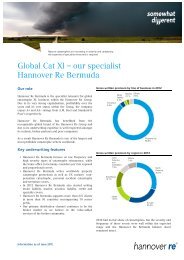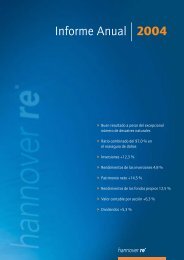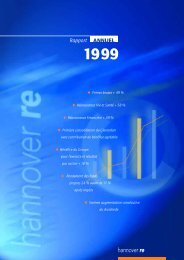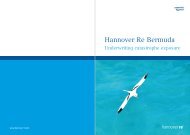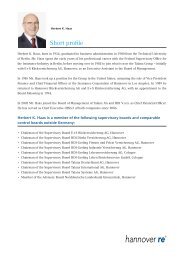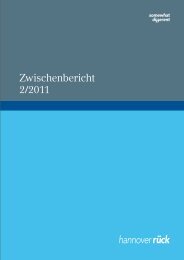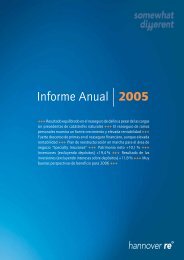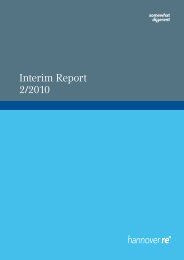Annual Report 2010 - Hannover Re
Annual Report 2010 - Hannover Re
Annual Report 2010 - Hannover Re
You also want an ePaper? Increase the reach of your titles
YUMPU automatically turns print PDFs into web optimized ePapers that Google loves.
3.2 Summary of major accounting policies<br />
<strong>Re</strong>insurance contracts: in March 2004 the IASB published<br />
IFRS 4 “Insurance Contracts”. The first standard governing<br />
the accounting of insurance contracts, it divides the “Insurance<br />
Contracts” project into two phases. IFRS 4 “Insurance<br />
Contracts” represents the outcome of Phase I and serves as<br />
a transitional arrangement until the IASB defines the measurement<br />
of insurance contracts after completion of Phase II.<br />
Underwriting business is to be subdivided into insurance and<br />
investment contracts. Contracts with a significant insurance<br />
risk are considered to be insurance contracts, while contracts<br />
without significant insurance risk are to be classified as investment<br />
contracts. The standard is also applicable to reinsurance<br />
contracts. IFRS 4 contains fundamental rules governing<br />
specific circumstances, such as the separation of embedded<br />
derivatives and unbundling of deposit components. In conformity<br />
with these basic rules of IFRS 4 and the IFRS Framework,<br />
<strong>Hannover</strong> <strong>Re</strong> is availing itself of the option of retaining<br />
the previously used accounting policies for underwriting items<br />
(US GAAP).<br />
Financial assets: as a basic principle we recognise the purchase<br />
and sale of directly held financial assets including derivative<br />
financial instruments as at the settlement date. The<br />
recognition of fixed-income securities includes apportionable<br />
accrued interest.<br />
Financial assets held to maturity are comprised of non-derivative<br />
assets that entail fixed or determinable payments on<br />
a defined due date and are acquired with the intent and ability<br />
to be held until maturity. They are measured at amortised cost.<br />
The corresponding premiums or discounts are recognised in<br />
profit or loss across the duration of the instruments using the<br />
effective interest rate method. Depreciation is taken in the<br />
event of permanent impairment. Please refer to our comments<br />
on impairments in this section.<br />
Loans and receivables are non-derivative financial instruments<br />
that entail fixed or determinable payments on a defined<br />
due date and are not listed on an active market or sold at short<br />
notice. They are carried at amortised cost; premiums or discounts<br />
are deducted or added within the statement of income<br />
using the effective interest rate method until the amount repayable<br />
becomes due. Impairment is taken only to the extent<br />
that repayment of a loan is unlikely or no longer expected in<br />
the full amount. Please refer to our comments on impairments<br />
in this section.<br />
Financial assets at fair value through profit or loss consist of<br />
securities held for trading and those classified as measured at<br />
fair value through profit or loss since acquisition. This refers<br />
principally to unsecured debt instruments issued by corporate<br />
issuers and derivative financial instruments. Within the<br />
scope of the fair value option provided under IAS 39 “Financial<br />
Instruments: <strong>Re</strong>cognition and Measurement”, according<br />
to which financial assets may be carried at fair value on firsttime<br />
recognition subject to certain conditions, all structured<br />
securities that would have needed to have been broken down<br />
had they been recognised as available for sale or under loans<br />
and receivables are also recognised here. <strong>Hannover</strong> <strong>Re</strong> makes<br />
use of the fair value option solely for selected subportfolios<br />
of its assets. In addition, derivative financial instruments that<br />
<strong>Hannover</strong> <strong>Re</strong> does not recognise as a valuation unit with underlying<br />
risks are recognised here. Securities held for trading<br />
and securities classified as measured at fair value through<br />
profit or loss since acquisition are carried at their fair value on<br />
the balance sheet date. If stock market prices are not available<br />
for use as fair values, the carrying values are determined using<br />
generally acknowledged measurement methods. All unrealised<br />
gains or losses from this valuation are recognised in net<br />
investment income. The classification of financial assets at fair<br />
value through profit or loss is compatible with <strong>Hannover</strong> <strong>Re</strong>‘s<br />
risk management strategy and investment strategy, which are<br />
oriented extensively towards economic fair value variables.<br />
Establishment of the fair value of financial instruments carried<br />
as assets or liabilities: the fair value of a financial instrument<br />
corresponds to the amount that <strong>Hannover</strong> <strong>Re</strong> would<br />
receive or pay if it were to sell or settle the said financial instrument<br />
on the balance sheet date. Insofar as market prices are<br />
listed on markets for financial instruments, their bid price is<br />
used. In other cases the fair values are established on the basis<br />
of the market conditions prevailing on the balance sheet date<br />
for financial assets with similar credit rating, duration and return<br />
characteristics or using recognised models of mathematical<br />
finance. <strong>Hannover</strong> <strong>Re</strong> uses a number of different valuation<br />
models for this purpose. The details are set out in the table on<br />
page 117. For further information please see our explanatory<br />
remarks on the fair value hierarchy in Section 5.1 “Investments<br />
under own management”.<br />
Financial assets classified as available for sale are carried<br />
at fair value; accrued interest is recognised in this context.<br />
We allocate to this category those financial instruments that<br />
do not satisfy the criteria for classification as held to maturity,<br />
loans and receivables, at fair value through profit or loss or<br />
trading. Unrealised gains and losses arising out of changes<br />
in the fair value of securities held as available for sale are<br />
recognised – with the exception of currency valuation differences<br />
on monetary items – directly in equity after deduction<br />
of deferred taxes.<br />
116 NOTES 3.2 Summary of major accounting policies<br />
<strong>Hannover</strong> <strong>Re</strong> Group annual report <strong>2010</strong>



